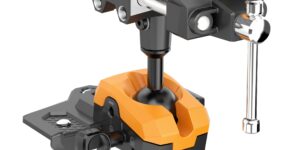Condition Monitoring of Greases
Achieving proper lubrication for maximum bearing and grease life.
Posted: August 24, 2022
KEY CONCEPTS
- While lubrication costs are a relatively small percentage of total maintenance costs at manufacturing plants (e.g., approximately 5% at steel plants), the potential impact of grease life can be much higher when downtime in process industries can cost from $10,000 to $100,000 per hour.
- Effective grease trending and testing can minimize unplanned repairs, downtime and disruptions, while extending the life of machinery.
- Effective condition monitoring programs collect data that allow preventive action to be taken to achieve optimum bearing and grease life without unplanned downtime.
In a grease lubricated bearing, the life of both the grease and the bearing can be maximized by properly using different forms of condition monitoring. Condition monitoring is the act of taking measurements (e.g., acoustic emission ultrasound and grease analysis) to identify any changes that could predict impending equipment or lubricant failure. Predictive maintenance, or condition-based maintenance, is taking action as a result of those measurements.
The goal of condition monitoring programs is to perform only as much maintenance as is necessary to avoid unplanned downtime. STLE member Kuldeep Mistry, engineering researcher and product development specialist at The Timken Co. in North Canton, Ohio, noted that understanding grease conditions, degradation trends and wear rates can both extend machinery life and minimize downtime. As organizations recognize how condition monitoring programs can increase reliability and reduce costs, these programs are becoming more common.
The condition monitoring of lubricating oils and greases (e.g., hydraulic, compressor, gear, turbine) while they are still in use is well defined and fairly standard across the industry. The key to effective condition monitoring is performing the right tests on the right equipment at the right time to predict when maintenance is needed.
Sampling difficulties
Rolling element bearings are commonly lubricated with grease instead of oil. STLE member Anoop Kumar, senior staff scientist with Chevron Inc. in Richmond, Calif., said that more than 90% of rolling element bearings are grease lubricated. The variety of configurations, ranging from small high-speed bearings to large, heavily loaded, slow-moving bearings, coupled with the low flow properties of grease, can present challenges in obtaining samples for analysis.
Kumar noted that in steel plant applications where greases can be pumped through a centralized lubrication system to the roller bearings while operating under high temperatures, pulling used grease samples may be more challenging. Even in manually lubricated bearings, the semi-solid grease is “hard to flow and is therefore difficult to take samples of for testing.” Therefore, equipment has been developed to make collecting grease samples possible.1, 2
Condition monitoring for maximum grease life
Effective grease trending and testing can minimize unplanned repairs, downtime and disruptions, while extending the life of machinery. Mistry listed the use of possible tests including wear particle analysis, percent oil within grease, emission spectroscopy, RULER (remaining useful life evaluation routine), property analysis, compatibility testing and performance testing.
FTIR can be used to examine the degraded oil or thickener within a grease or the contamination within a grease. Energy dispersive X-ray fluorescence spectrometry or inductively coupled plasma mass spectrometry can be used to investigate the inorganic species for additive depletion, wear element concentration and contamination. Comparing the change in the composition of used grease against fresh grease is one test process. Bleed-rate measures the oil release rate from the grease in comparison with the fresh grease. Percent oil in grease investigates the lubricating oil remaining within the grease, while pressure differential scanning calorimetry (PDSC) is used to determine the oxidative stability within the grease.
Condition monitoring for proper lubrication
According to Mistry, “Grease selection, application method, volume and frequency of grease delivery are fundamental considerations needed for quality grease lubrication for bearings.” The requirements for the grease used in each application hinge on temperature, the operating environment and the load.
He noted that different industries have different grease selection and application methods, and that even within a specific industrial application, different components might need different greases. Selection should be “fine-tuned based on feedback from visual inspections, operating temperature and acoustic monitoring.” These are combined with base oil viscosity, additive requirements, base oil type, thickener type and concentration, consistency, operating temperature range and dropping point of the grease. All of these factors also come into play for grease condition monitoring.
Mistry emphasized that as with oil condition monitoring, it is important that grease condition monitoring consider the trends or changes in the pattern of the results from previous samples, comparison of field samples to a fresh grease sample and not to completely rely on the laboratory interpretation of the data.
He said, “The total service life of the greases is typically determined by the bearing tests,” which are intended to determine grease life for given loads, temperature and speed for different grease thickener types or formulation. Bearing geometry also is an important consideration as different grease thickeners might work differently for different bearing design.
Mistry noted, “It is not always possible to know the amount of and the condition of old grease in the housing at the time of reapplication, making it important to modify the calculated values with a condition-based approach.” Mistry also cited the use of acoustic instrumentation as one advanced condition-based technique that can optimize the relubrication volume. This type of technique is “proactive” rather than “reactive” condition monitoring.
Different industries and plants tend to adopt their own approach to assessing in-service grease condition monitoring based on the plants’ operating conditions with respect to temperatures, loads, speeds and seals. Kumar noted that one approach “is to conduct trials before switching over from one type of grease to another to estimate the relubrication interval.”
Case study
G.R.P. Singh, head of the Quality Assurance Group in the One Shared Services Technology Group of Tata Steel in Jamshedpur, India, notes the importance of grease to the steel industry. Singh said, “Most of the bearings in a steel plant are grease-lubricated.” In addition, he noted that approximately 60% of equipment failures at the steel plant are lubrication related. While lubrication costs are only 3%-5% of the total maintenance costs at the steel plant, Singh said the impact of lubrication on plant performance is very high.
They have tried to standardize greases based on the greases’ past performance in a particular application. As examples, Singh noted that polyurea grease is used in caster applications, while lithium calcium grease with 460 base oil viscosity is used in hot strip mill applications.
The plant uses OEM recommendations to determine the change-over period for grease in a particular application. The OEM recommendations also are supplemented by grease ferrography and FTIR analysis from their dedicated lubrication laboratory to see how the grease has actually performed during use. With high performance greases, they are trying to increase the change-over period while maintaining overall performance.
Components of bearing lubrication
Mistry noted that grease life is essential to bearing performance. Replacing bearings can be an expensive proposition in a plant with thousands of bearings, especially when downtime in process industries can cost from $10,000 to $100,000 per hour.
Kumar concluded, “The important components of bearing lubrication are selection of the right lubricating grease for the particular application, the application method, the optimum quantity of grease dispensed and the frequency of lubrication.” By following proper practices, optimum bearing and grease life can be achieved. While assessing grease life analysis, Kumar also recommended simultaneously performing gear or bearing inspections for possible wear and tear.
For Further Reading
Aikin, A. R. (2021), “The process of effective predictive maintenance,” TLT, 76 (2), pp. 34-40. Available at www.stle.org/files/TLTArchives/2021/02_February/Feature.
End Notes
- http://store.greasethief.com/grease-sampler-adjustable-t-handle/.
- http://store.greasethief.com/grease-sampler-kit-pillow-block-bearings/.
Reprinted with permission from the May 2021 issue of Tribology & Lubrication Technology (TLT), the official monthly magazine of the Society of Tribologists and Lubrication Engineers, an international not-for-profit professional society headquartered in Park Ridge, Ill., www.stle.org. Available at https://www.stle.org/files/TLTArchives/2021/05_May/Best_Practices.aspx.
Subscribe to learn the latest in manufacturing.











